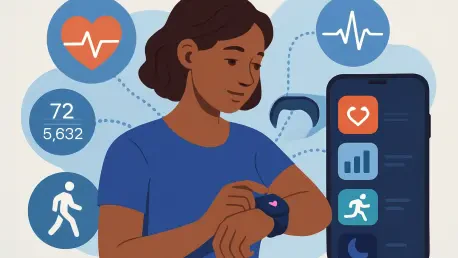I’m thrilled to sit down with Ivan Kairatov, a renowned biopharma expert whose extensive experience in technology and innovation has shaped groundbreaking advancements in the industry. With a strong background in research and development, Ivan has been at the forefront of integrating digital tools into health studies. Today, we’ll dive into his insights on the American Life in Realtime (ALiR) study, exploring how it’s redefining equitable health data collection, the power of person-generated health data, and the role of wearable technology in addressing historical biases in precision medicine.
Can you give us a broad picture of what the American Life in Realtime (ALiR) study is and why it was created?
Absolutely, I’m excited to talk about ALiR. This study is a pioneering effort to collect person-generated health data, or PGHD, through wearable devices and a custom mobile app, all provided by the study itself. The main goal is to create a nationally representative dataset that truly reflects the diversity of the U.S. population. Unlike many other studies that rely on participants owning their own devices, ALiR was designed to break down barriers by ensuring access to technology for everyone involved. We wanted to address the gaps in precision health research and build a benchmark for fair, reproducible results that can drive better health outcomes across all communities.
Why do you think person-generated health data is such a game-changer for health research?
PGHD is transformative because it captures real-time, continuous insights into people’s lives—things like physical activity, sleep patterns, heart rate, and even mental health through self-reported surveys. This data comes directly from individuals via wearables and apps, giving us a window into daily behaviors and environmental exposures that traditional clinical data often misses. What’s really powerful is how it can spotlight health inequities, especially for marginalized groups. By understanding these patterns, we can tailor interventions and improve outcomes for populations that have historically been overlooked in research.
One issue the study highlights is bias in existing health datasets. Can you unpack what these biases look like and who they affect most?
Sure, biases in health datasets often stem from underrepresentation of certain groups. Many studies, even large ones, tend to skew toward White, higher-income, and younger participants, leaving out Black, Indigenous, older, and lower-income individuals. This happens partly because of recruitment challenges, like limited access to technology or mistrust in research. When these groups are missing, the results—and any tools developed from them, like AI models—can’t be generalized. They might work well for some but fail others, which can actually widen health disparities instead of closing them.
How did the ALiR study approach the challenge of including those underrepresented groups in a meaningful way?
We tackled this head-on with a few key strategies. First, we used probability-based sampling to randomly select participants from a large, address-based panel of U.S. adults, ensuring a cross-section of the population. We also oversampled racial and ethnic minorities and lower-education groups to balance representation. On top of that, we provided wearable devices and internet access through tablets to those who didn’t have it, removing technology as a barrier. These steps helped us achieve a cohort that’s much more reflective of the real U.S. demographic landscape than many convenience-based studies.
Can you walk us through the types of data ALiR collects and how this variety paints a fuller picture of health?
ALiR gathers a wide range of data to create a holistic view of health. Through wearable devices, we track biometrics like heart rate, steps, and sleep quality continuously. The mobile app complements this with short surveys—done every one to three days—covering physical and mental health, behaviors, social factors, and structural issues like income or experiences of discrimination. We also link this to external datasets, such as healthcare records, weather, air quality, and even local crime stats, to understand environmental influences. This combination lets us see how different factors interact to shape health over time.
The ALiR study outperformed other datasets in testing a COVID-19 detection model. Can you explain what that success tells us about the study’s design?
That’s one of the results I’m most proud of. When we trained a COVID-19 detection model using ALiR data, it achieved a high performance score—known as area under the curve, or AUC—of 0.84, and this held steady across different groups and testing scenarios. This consistency shows our data’s generalizability, meaning the model works well for diverse populations. In contrast, models trained on less representative datasets saw significant drops in accuracy when applied to broader groups. ALiR’s success here underscores the value of inclusive, high-quality data collection over just having a larger, but biased, sample.
What do you see as the biggest hurdles still facing equitable digital health research, even with studies like ALiR paving the way?
While ALiR made great strides, challenges remain. One is long-term engagement—keeping participants involved over time, especially older adults who may face barriers beyond just tech access, like mistrust or lack of interest. Another is addressing subtle biases that persist despite our efforts, such as slight underrepresentation of certain groups like retirees. Beyond that, scaling these inclusive designs to larger studies without losing quality is tough. It requires resources, thoughtful planning, and ongoing community trust-building to ensure everyone feels their voice matters in research.
What’s your forecast for the future of precision health with initiatives like ALiR setting new standards?
I’m optimistic about where precision health is headed. With studies like ALiR creating public benchmarks and openly sharing data—ours will be available in late 2025—we’re laying the groundwork for more equitable AI tools and interventions. I think we’ll see a shift toward studies that prioritize representation from the start, not as an afterthought. Technology will keep advancing, making data collection even more seamless, but the real progress will come from pairing that with trust and accessibility. In the next decade, I believe precision health can truly live up to its name, personalizing care in ways that benefit everyone, no matter their background.









